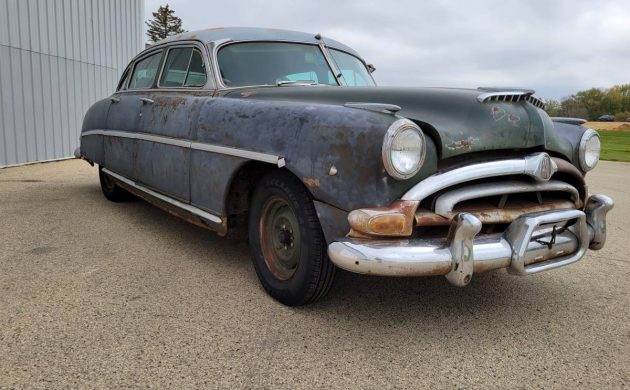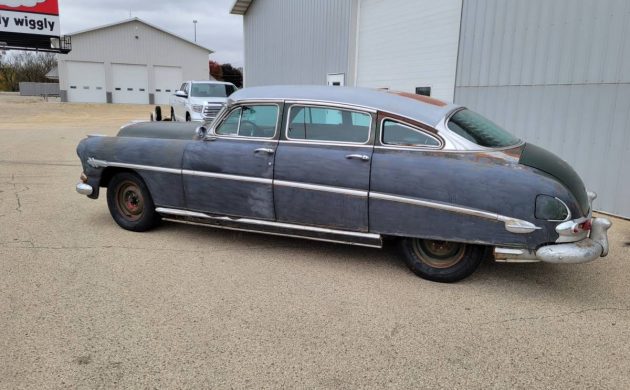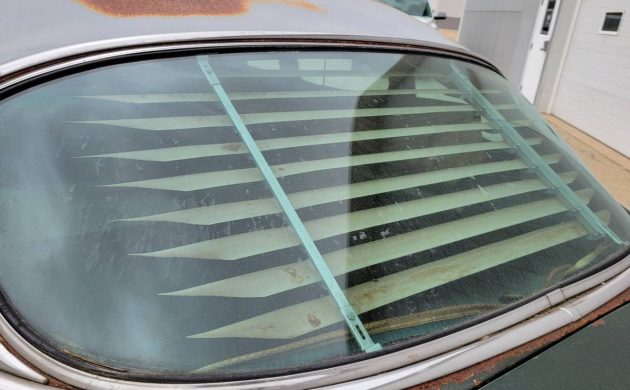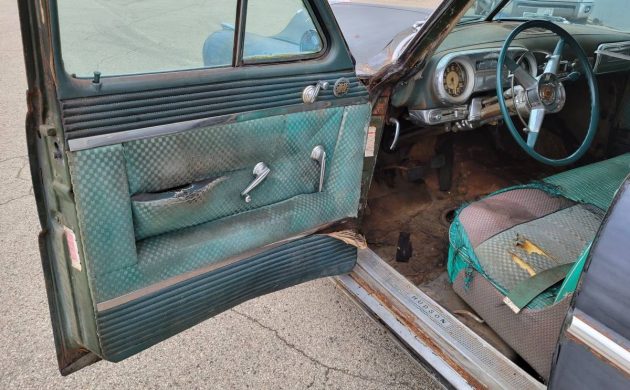This 1953 Hudson Hornet with “Twin H Power” is listed here on Craigslist in Milwaukee, Wisconsin, and looking over its faded glory is practically an archaeological experience. The cool aesthetics of the early 1950s are revealed.
Make no mistake, the Series 7C Hornet sedan with only 35,396 original miles is a project car needing lots and lots of work. It’s thoroughly worn out, but good bones are evident, and it is very complete. What’s missing is in the trunk or (fog lights, lower fender skirts, trim) included.
These “Step Down” Hudsons, with a lowered floorpan, are absolutely gorgeous when restored. This example is from the penultimate year of the Hornet and has the desirable two-carb “Twin H Power” option, connected to the equally desirable three-speed manual with overdrive. Excellent specs for this car.
The original two-tone color scheme, still there under the blue-tinted rust, was honey cream and green, with a green check weave interior. It’s all ratty now, but restorable, right down to the robe rail. The correct (original too?) 308-cubic-inch inline six is in place and turns freely. The owner says 210 horsepower but sources say 170 for the standard Twin H car. To get to the claimed 210, you’d need the available 7-X modification. The car deserves to be stripped to the chassis and ground-up restored. It won’t be cheap, but possibly rewarding.
The Hornet, introduced in 1951, had a colorful race history, which the owner recounts: “Hudson was the first automobile manufacturer to get involved in stock car racing and dominated the track for many years, which was quite the accomplishment. The competition was formidable, and Hudsons were known for being heavyset and relatively luxurious for the price point. But, thanks to some exceptional chassis engineering, which included a low center of gravity, durable and powerful engines and some very talented drivers, the Hudson Hornets wowed America and gave the competition something to beat.”
The Hornet dominated NASCAR in the early 1950s, piloted by Marshall Teague, Herb Thomas, Dick Rathmann, Frank Mundy and others. Hudson won 27 of 34 NASCAR Grand National races in 1952, and 17 of 37 in 1954 (when the design was getting a little dated).
Hornets were sold as two-door coupes, four-door sedans such as this example, a convertible, and pillarless hardtop coupe.
The starting price for a Hornet was $2,543. There were only minor changes on the 1953 model. The company sold 27,208 Hornets. The radio—included on this car—was a $100 option.
By 1954, Hudson was being killed for lacking a V-8 engine, and the company was ripe for takeover by Nash-Kelvinator. The new combine was American Motors, and the last made-in-Detroit Nash cars rolled out in October of 1954. The second-generation of the Hornet was built in Wisconsin, which is where the car for sale is located.
Classic.com lists a first-generation Hudson Hornet at an average of $82,258, so the buyer of this example has some restoration funds to spend without going underwater.












I’m fairly sure this is the same car I used to see parked near my workplace about 12 years ago.I was amazed at the enormous bulk of it—more like a limo than something you’d expect to see parked in a driveway. Glad to know its still around and may find a good home.
You had me at rear window Venetian blinds…
Seeing one of these reminds me of “On The Road” and that photo of Neal Cassady at the wheel of a Hudson with a girl at his side.
One of the few 4 doors I wouldn’t mind owning.
Two neighbors had them, big, fast, comfortable, enormous back seat space, but could rust faster than even the Chrysler products of the time. One neighbor’s rusted in the front fenders above the headlights, along with rocker panels and fenders behind the wheel wells, pre-Bondo, so solved with tape and paint that almost matched, but was mechanically so sound that he did not want to give it up. Other’s was rust free, had not been driven much, only on weekends, took the train to work, many wives did not drive back then, so it was garaged most of the time. What amazes me is that my 2002 Audi had no rust despite 18 years in New England being driven year round and not always garaged. Cars are better now.
Yes, more function over form these days, they’ve finally figured out where the road salt sits to do its business. Ah, but what a tip of the hat to the days of “Form” 😊
Not all of them !
With the whole cars movie thing I’m kinda surprised they aren’t asking more for it
“first generation Hudson Hornet at an average of $82,258 ” is a bit overzealous thinking. … It would take 100 Grand to make this an 80,000 car… and 50, to make it bring 40… and it not the desirable 2 door , either
I bought one a few years back from New York.It was the RUSTIEST thing you have ever seen underneath.I was quoted £15000 to repair.Ended up breaking it.
Average of $82,258? I don’t think so. I have a 1951 (first year for Hornet) Hornet Hollywood in excellent condition. And as much as I love the car, the first $82,000 takes it. As far as horsepower, the standard Hornet engine has 308 cubic inches and with a single carb is rated 145 hp. The dual carb version (Twin H, as in the photos above) is 160 hp, unless Hudson made some changes in 1953 which raised it to 170 hp.
Rob, I envy you having the Hollywood. We have a ’53 that has been in our family since 1959 – a dark blue with the checkerboard cloth 4dr. I grew up driving these as my Father believed them to be the best engineering available – even after we got a Chrysler-Plymouth franchise. He conveniently always had me change those “wonderfully smooth” cork clutches – with the caveat that it was to give me experience. We haven’t driven it for ten years and it is now at my sister’s house in southern Oregon. These give me the sense that I am truly enclosed in a metal cocoon, and I miss that security. And the sound of the tube radio “warming up”.
Dave,
I’m sure you know, but I thought the following Hudson clutch info was important for everyone to know:
Hudson stickshift cars always had clutch friction material made of small round sections of CORK, the same basic stuff used in wine bottles. The cork was kept supple by bathing it in 8 ounces of a special light weight machine oil. If one kept the clutch oil level from dropping, and didn’t abuse the clutch, they would practically last forever.
However problems arise when the car is allowed to sit for long periods of time. That 8 oz of fluid does not cover all the cork surfaces, just what settles to the bottom of the clutch case. On a non-running car, the best way to ensure the clutch is lubricated is to put the transmission in neutral, and then turn the engine over by hand until the entire clutch disc has been in touch with the clutch fluid.
If the engine crankshaft cannot be rotated, it’s suggested that a long piece of 2X4 lumber be placed between the clutch pedal and the steering wheel, so the clutch pedal is kept depressed. If this is not followed, and the cork dries out, it can adhere to the clutch flywheel, and when the clutch pedal is depressed, it can shear off the cork pads from the clutch disc. This will require a clutch overhaul.
If you find a Hudson with stickshift, and it’s not been running in years, plan on figuring in the costs involved with replacing the clutch. Fortunately the correct clutch discs are still available, as is the correct fluid.
1953 was the year of the great GM Hydra-Matic factory fire. Hudson used the Hydra-Matic, so for about 6 months, only stickshift Hudsons were manufactured. While GM was willing to supply Buick Dynaflow transmissions modified to fit Cadillac, Oldsmobile, Pontiacs, and a few GMC trucks, GM basically said “Sorry” to Hudson and Lincoln.
In the early 1980s I owned a nice original 1953 Cadillac Fleetwood 60S equipped with a Dynaflow, and I remember when the traffic light turned green and I floored the gas pedal, it took at least 5 minutes of engine roar before the car began moving forward!
PS- All of the Hudsons I remember from the ’50’s had the horsepower number on a badge just below the driver’s wing window. I had only seen 145 or 170. 7X was not factory installed.
A parts car – but I love the blue-tinted glass all around. Some Mopars of this era had a similar tint.
How many of you noticed the unusual dual round accessory mirror above the driver’s vent window? It has a mirror pointing to the rear of the car, but has another mirror a few inches away that points in the opposite direction [forward]. It’s not designed to be used as a rear view mirror, that’s covered by the regular rear view mirror on the driver’s door.
I’ve actually had one of these weird accessory items new in the box, with the instruction paperwork on how to use it. Anyone think they know what it’s used for? Here’s a hint: In a step-down Hudson, the driver sits much further back from the windshield than most other cars.
Bill – It must be Sunday. I know what it is for as our car has one, too. It is also equipped with curb feelers, antenna boosters and dual spotlights – just the way my dear Father outfitted all of his Hudsons. He bought Pendleton blankets to use as seat cover and got huge safety pins to tie them to the pull cord on the seat back. My sisters were small enough to lay in the floor by the heater while I slept in the back window. I guess when he got back from WWII the cars made a huge impression on him that stayed with him until the Cadillac (54-62) phase followed by his Lincoln phase (61-79). Being his son was unique and interesting but I was too stupid to appreciate him fully until he was gone.
It’s a “Passing Eye” (qv) accessory.
Lou,
You are correct, and actually there are 2 possible answers, as per advertising in the JC Whitney catalogs in the 1950s. The other answer is that the forward facing mirror could be aligned for the driver to see overhead traffic lights at an intersection. From what I have been able to figure out, the device was sold by the “Passing Eye Co of Kenosha WI”, and it was their only product.
Anyone who has ever driven a step-down Hudson in downtown traffic knows with that short windshield placed a couple of feet forward from the driver’s eyes, the traffic lights are hard to see.
Around 1949 Fulton Sunshield Co introduced a Plastic prismatic lens that mounted either to a screw holding the windshield molding in place, or by using a suction cup on the glass. These were sold as the “Fulton Traffic Light Finder”, and was often sold as part of a package when you bought a new Fulton Sunshield for the car’s windshield
Here’s a link to an ebay ad where a used one is for sale for over $200! https://www.ebay.com/itm/224832497419?nma=true&si=AigBMnloasmRFPzuie2IHJ9SHw4%253D&orig_cvip=true&nordt=true&rt=nc&_trksid=p2047675.l2557
In 1955 Delco Div of GM came out with an improved traffic light viewer in polished glass. These have been reproduced under GM license, and can be bought on the internet for under $40.
Used to see Hornets racing at the Langhorne Speedway as a kid I never missed a race. The Hornets might not have been the fastest but were hands down the best handling.To watch the Hornets clinging to the inside was a thrill while the Olds and Buicks were unable handle with them with all the V/8 power.
Dave,
Email me; billmcoskey (at) aol dot com and let me know what you think it does!
Your father sounds a lot like my mentor growing up, except it was Packard automobiles, not Hudsons. He had a 1950 Packard Standard Eight fastback [the cheapest Packard that year] and it literally bore every possible PMCC option, from the remote spare tire inflator, to “Big Bird”, AKA the Cormorant hood ornament.
In the mid 60s, there were 3 step-down Hudson’s in the back yard of a home on the main street of my small home town. They were all hauled to the local car dump ground, a gravel pit about a half mile out of town. I spent most of my summer days in that gravel pit, usually riding my bike through town with a .22 rifle on my handlebars. (Try that nowadays).
One of the Hudson’s had the Twin H engine. I took the emblem off the deck lid and tried to take the complete intake set up. Being about 11 years old, I couldn’t get the intake bolts loose, but took the carbs, linkage and air cleaners. They hung in my stash (the back porch of our house) for a few years but I became much more interested in 55 Chevys as I approached legal driving age, so I traded them for Chevy parts somewhere along the line.
I still really like the step down Hudsons and if I didn’t have enough projects to last until I’m 150 years old, I’d love to have one like this.